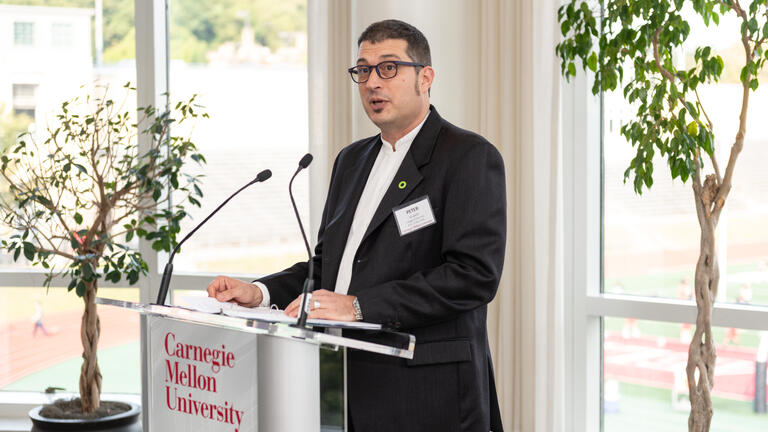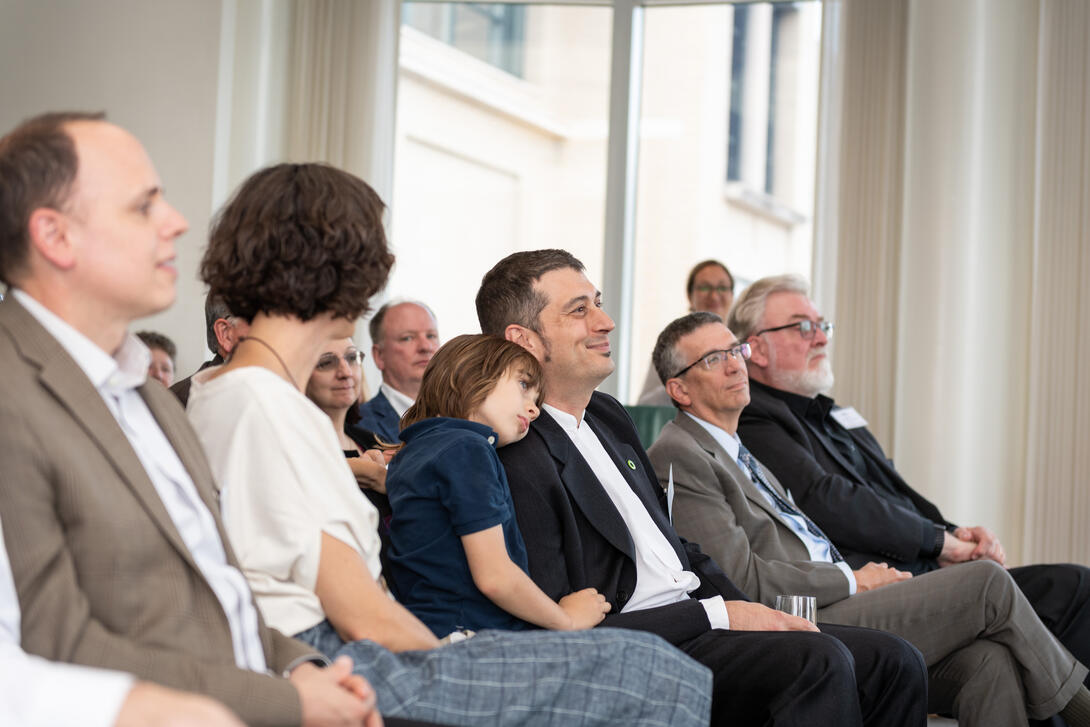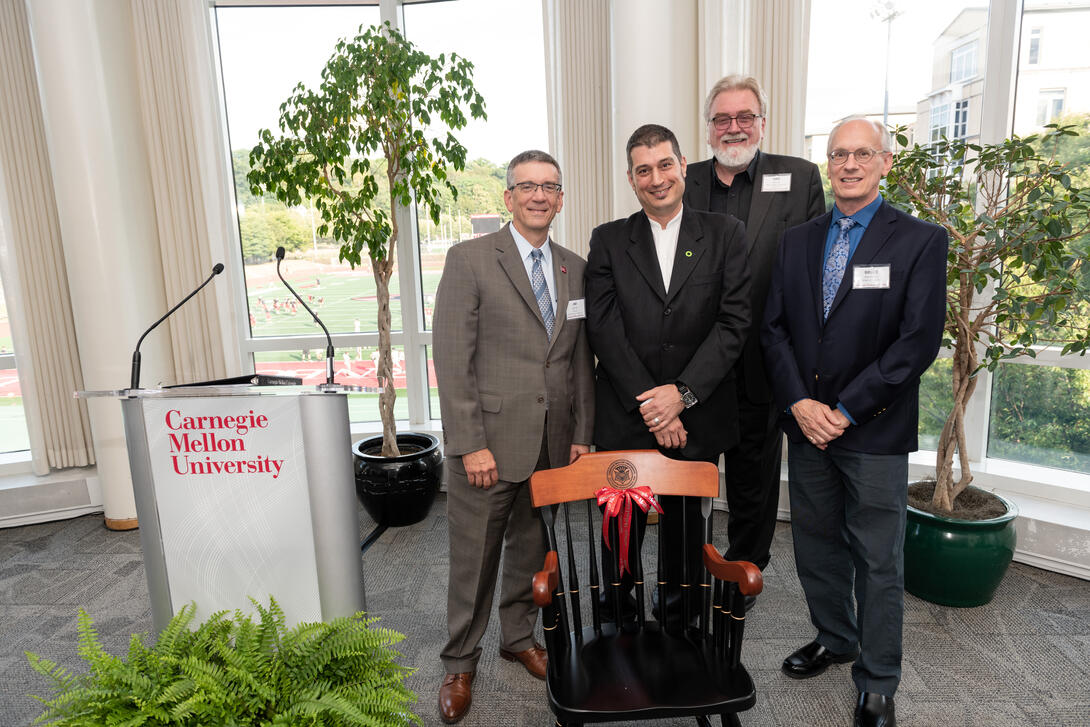Design’s Peter Scupelli Begins Tenure as Nierenberg Chair

Carnegie Mellon University’s School of Design is honored to announce that Peter Scupelli has been named as the 2019-2022 Nierenberg Chair. Peter Scupelli is the Founder and Director of the Learning Environments Lab and is currently teaching required undergraduate and graduate-level courses in the School of Design. During his three-year tenure as the Nierenberg Chair, Scupelli plans to focus on sharing the sustainability centered courses that he has developed at CMU with the world as open-source teaching resources.
The Nierenberg Chair was established in 1983 through a generous gift from the late Mr. Theodore D. Nierenberg and his wife, Martha. The Chair is one of the most prestigious appointments within design education in the United States, awarded to an outstanding individual who has achieved national or international prominence in design or a design-related field. Originally applied to visiting faculty, the Chair has more recently been awarded to full-time faculty in the School of Design.
“I felt many emotions all at once. I was surprised, shocked, flattered, humbled, and elated. I was not expecting such recognition and support for my work at CMU,” said Scupelli after learning of his nomination. “It is such a great honor to be nominated to be the Nierenberg Chair. I've admired so many of the past Nierenberg chairs for their contributions to the field of Design and the impact that they had on the School of Design.”
Scupelli has been a lifelong advocate for environmental issues. As a Cub Scout and a Boy Scout, he was involved in trying to leave the world in a better condition than he found it. He engaged in activities like cleaning up litter or volunteering in community organizations.
“My appointment as Assistant Professor in the School of Design at CMU in 2011 and the birth of my son, Felix, instilled in me a fierce urgency to engage in sustainability issues on more broadly than mere personal virtues like resisting the lure of central air-conditioning at home, reducing energy consumption with LED lights, insulating the home, using EnergyStar appliances, and commuting to work by bike year-round,” added Scupelli.
From there, Scupelli began research collaborations on energy use information dashboards in office environments with Architecture Professor Vivian Loftness and Azizan Abdul-Aziz, an Assistant Research Professor at the Center for Building Performance and Diagnostics in CMU’s School of Architecture.
In 2011, Scupelli noticed two gaps in the School of Design curriculum in terms of sustainability: value-based design and design for long-time horizons. In 2014, the School of Design launched a new mission and new curriculum centered on transitioning toward societal-level sustainability.
“I developed five new courses to support the vision through value-based design (i.e., Design Ethos and Action) and design for long-time horizons (i.e., Dexign Futures, Introduction to Dexign the Future, Dexign the Future, and Futures),” said Scupelli. “The term ‘dexign’ was invented by Arnold Wasserman in the Dexign the Future course we co-taught in 2013. Dexign indicates an experimental type of design that integrates design thinking with futures thinking to align short-term design action with long-term vision goals. My courses help students shift into long-term sustainability centered professional practices and values-based design.”
Scupelli’s Dexign Futures courses are built around a “flipped” classroom pedagogy. Traditionally, flipped courses have two components: interactive online pre-work followed by hands-on applied in class activities. The lectures and instructions for these courses take place outside of class so that class time can be dedicated to hands-on activities. Online homework prepares students for in-class activities where the course instructor can provide students with immediate feedback. The flipped classroom pedagogy has been successful with large class sizes for STEM based courses.

“Due to School of Design curricular choices, my challenge was to find an innovative way to teach new design subjects such as futures thinking with three times as many students in half of the time compared to a traditional studio course,” said Scupelli. “I decided to use the flipped classroom pedagogy to teach design. Since STEM education differs from traditional design studio education, I created my own version of flipped classroom pedagogy specifically for design based learning. Scupelli received a Wimmer Faculty Fellowship in 2013-2014 and credits Judy Brooks, Marsha Lovett, and their teams from Eberly Center for Teaching Excellence and Innovation for mentoring and supporting him in the past six years through data driven experimentation with his courses and the OLI components to the Dexign Futures courses.
“My design-centered, flipped-classroom pedagogy has three components: online interactive pre-work with immediate correctness feedback, in-class hands-on workshop activities with instructor feedback, and weekly reflective assignments followed by in-class group discussions to encourage metacognition. In the Fall of 2019, I am conducting research with David Gerritsen from the Eberly Center on student-instructor classroom dynamics for the Dexign Futures course in the Eberly Center’s new Technologically Enhanced Learning (TEL) classroom. The TEL classroom is a sensor-rich environment that can video record classes, detect student gaze direction, facial expression, and so forth. I’m studying how student-instructor interactions within teams are associated with learning outcomes.”
These coursework exercises in the Dexign Futures course are being noticed by K-12 grade educators. Doris Wells-Papanek from Design Learning Network (DLN) used course materials from Dexign Futures to inspire her K-12 global design challenges deployed in the United Kingdom, China, and the USA. Scupelli and Wells-Papanek have co-authored a paper describing how such initiatives can attract more diverse students to consider design careers.

The Dexign Futures course and Design Ethos and Action courses are also being developed by Scupelli into open-source courses that will be deployed on a global scale. Both courses will be translated into Chinese in partnership with a team led by Professor FU Zhiyong from Tsinghua University. Both courses are scheduled to be released globally in English on CMU’s Open-Learning Initiative (OLI) platform by Spring of 2020. Scupelli is also working with Professor Anna Barbara from Politecnico di Milano, School of Design and Professor Carl DiSalvo from Georgia Tech to pilot open-source materials from the Dexign Futures course in the courses they teach.
Scupelli believes that CMU is uniquely poised because of recognized excellence in both the technical and creative colleges.
“You can come here with a dream and discover even more interesting and better dreams opportunities that you hadn't even imagined existed,” said Scupelli. “You might be introduced to somebody from a different department that really broadens your horizons and design practice. Nineteen years ago my plan was simple. Get a master’s degree in interaction design from the School of Design at Carnegie Mellon University to transition from a traditional architecture practice in Milan, Italy into well-paid design work in Silicon Valley or New York City. However, three unexpected nudges put me on a different path and transfigured the course of my life. First, as I researched my master’s thesis and I felt a sense of fulfillment missing in my professional practice. Second, as a graduate course instructor, I fell in love with teaching. Third, the unsustainability of the status quo and the urgency of Climate Change led me to dedicate my teaching to prepare the next generation of designers to rise to such challenges.”